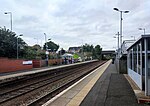RAF Pitreavie Castle
Buildings and structures in DunfermlineCategory A listed buildings in FifeGovernment buildings completed in 1938Military command and control installationsMilitary installations in Scotland ... and 5 more
NATO installations in the United KingdomOrganisations based in FifeRoyal Air Force stations in ScotlandRoyal Air Force stations of World War II in the United KingdomRoyal Navy bases in Scotland

Royal Air Force Pitreavie Castle or RAF Pitreavie Castle was a station of the Royal Air Force located at Pitreavie Castle in Dunfermline and near Rosyth, Fife, Scotland. Built in the early 17th century, the castle was sold to the Air Ministry in 1938. An underground bunker was constructed and the station was used to coordinate the operations of RAF Coastal Command and the Royal Navy during the Second World War. The station was subsequently used as a UK and NATO maritime headquarters before closing in 1996. It is now in residential use.
Excerpt from the Wikipedia article RAF Pitreavie Castle (License: CC BY-SA 3.0, Authors, Images).RAF Pitreavie Castle
Castle Brae, Dunfermline Pitreavie
Geographical coordinates (GPS) Address Nearby Places Show on map
Geographical coordinates (GPS)
| Latitude | Longitude |
|---|---|
| N 56.048422222222 ° | E -3.4169555555556 ° |
Address
Castle Brae
Castle Brae
KY11 8PF Dunfermline, Pitreavie
Scotland, United Kingdom
Open on Google Maps









